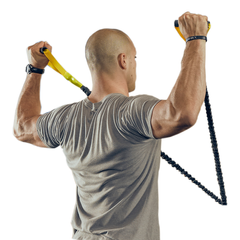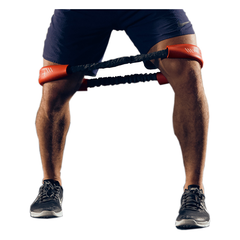Any type of pain can be complicated and frustrating, but that's especially true for shoulder pain. A bad shoulder is a nagging issue that can hold you back from enjoying your favorite activities and may persist for months to years despite repeated efforts to solve it.
But rest assured that there is hope, and with a consistent plan of attack, you can get back to your life pain-free and performing even better. It only takes a simple approach of relative rest and a daily exercise routine to strengthen and stretch your shoulders.
It's the same formula that's helped thousands, and there's a good chance that it will help you too, even with issues like rotator cuff and labrum tears. We'll walk you every step of the way with our 30-Day Shoulder Fix, but before diving in taking our Red Flag Shoulder Screen to determine if it's the right program for you.
The Red Flag Shoulder Screen
The Red Flag Screen will assess for more complex issues that should seek guidance from a medical professional. These assessments will help identify problems that may need more advanced treatment or potential surgery to fix the problem.
1. Neck or Spine Disorders
Pain or a significant limitation in the range of motion of the neck or spine is a Red Flag and reason to see a sports medicine professional. It's ok if you cannot achieve the full range of motion. The goal is to assess for a significant limitation in range of motion and either pain, numbness, or radiating discomfort during the movements. If any of these conditions exist, visit a sports medicine professional.
2. Atrophy or Asymmetry
Atrophy, which describes the shrinking of muscle, will create an asymmetry when comparing one side of the body to the other. The atrophied muscle appears sunken in rather than rounded like the opposite side. Also, look for significant deviations in position or alignment between the right and left sides. Minor asymmetries of the resting scapula are expected, especially in athletes who compete in sports with a dominant side, like baseball players. Don't be too critical, as minor asymmetries are not Red Flags. You are only looking for obvious deviations such as muscle atrophy. These undeniable differences are Red Flags and should be evaluated by a sports medicine professional.
3. Obvious Dysfunctional Movement
Test this by raising the arms overhead in front of the body individually and then both arms simultaneously. The body shouldn't need to compensate with a lean to the opposite side or a full-body movement to elevate. Other issues may be a significant sudden jerk, collapse, or winging of the shoulder blade on the affected side compared to the normal shoulder. Look for these changes with both lifting and lowering. These noticeable dysfunctional movements are Red Flags and should prompt a visit to a sports medicine professional.
4. Numbness, Swelling, or Weakness
Look for persistent or recurring swelling or numbness from the shoulder to the hand. Additionally, check for noticeable strength limitations in the shoulders/arms/hands during simple daily activities, such as opening a door or washing your hair. Any of the above conditions meet the Red Flag criteria and should be evaluated by a sports medicine professional.
5. Shoulder Pain or Apprehension
Apprehension, which is the feeling that the shoulder will come out of the socket, is an issue to have evaluated. If certain shoulder positions make you feel like your shoulder may dislocate, this is a red flag and should be evaluated by a sports medicine professional.
Shoulder pain is not automatically a Red Flag. First, you should assess your pain for severity and limitation. Test your pain by lifting your arms at an angle in front of your body. Next, create a W with your arms. Pain so severe that you cannot move through these full ranges of motion, and you would describe it as a five on a scale to ten, is a red flag and should be evaluated by a sports medicine professional.
Results
If you answered no to the above questions, give the rehab approach a try and see how it works. The concerns are usually that you'll make things worse or that your issue will continue to decline to the point of no return, but rest assured that you will not be worse off than when you started, and it will only improve your outcomes.
We recommend a consistent 30-day trial to see how things improve, and if the issue is still unresolved, get a medical opinion on the best next steps. The worst-case scenario is that you'll have a more capable shoulder to take on the procedures that come next, but much more likely is that you'll resolve your pain without the costs and hassles of surgery and other medical procedures. Along with that, you'll be equipped for a long-term plan to keep your shoulders healthy and continue getting stronger.
Please continue to read up on common issues behind shoulder pain in our guide to shoulder rehab, starting with a common condition called shoulder impingement syndrome.
 Shoulder Packages
Shoulder Packages
 Hip & Core Package
Hip & Core Package
 Bundles
Bundles
 Accessories
Accessories



















